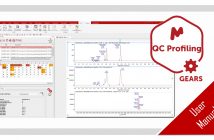In this tutorial, we will explain how to phase the spectrum in real time, directly on the 2D spectrum. We will show how to correct the phase of a gNHSQC experiment (see figure below).
Once you have opened the spectrum; 'zoom in' the area of interest (in this case, we only need to worry about the left half of the spectrum):
1. Then, take a look at the signal, or the group of signals (1a), which appear in a corner of the spectrum (for example, the signals highlighted with a green circle in the capture above); select 'manual correction' (1b) from the drop down menu on the 'Phase Correction' toolbar button and adjust the zero order (PH0) phase parameter along f2 (by dragging the mouse up or down over the blue rectangle in the 'Phase Correction dialog box' whilst holding the left mouse button (1c)).

The goal (1d) will be to make all the signals of the area of interest (highlighted with the green circle in the picture above) positive (note that in this example, positive signals are red whereas negative are blue). Remember that we are adjusting the phase along f2, so do not worry if the phase of the peaks along the indirect (vertical) dimension (f1) is not correct.
Next, if some peaks on the right side of the area of the spectrum shown on screen require phase correction (remember, still along f2), you can place the pivot point (1e) over the signal we have selected as reference (in the green circle) and carry out the first order phase correction PH1 (by dragging the mouse up or down over the blue rectangle in the 'Phase Correction dialog box' whilst holding the right mouse button). In this particular case, the spectrum does not require first order correction. 2. Finally, if necessary (as in this case), you can proceed in the same manner to correct the phase along f1. Just click on the f1 button on the dialog box and then proceed as explained along f2, by starting with a zero order phase correction and following with a first order phase correction (remember: along f1):
Bear in mind that this procedure is exactly the same as with 1D-NMR spectra, but it is necessary to correct the phase along 2 dimensions. Note that, in our specific example, the resulting spectrum has 3 negative signals, but this is something that a phase correction is not able to correct.





